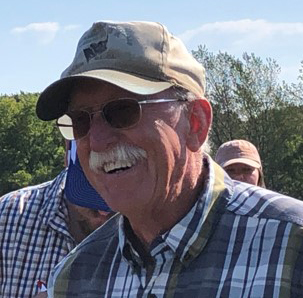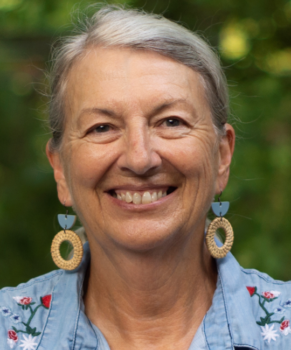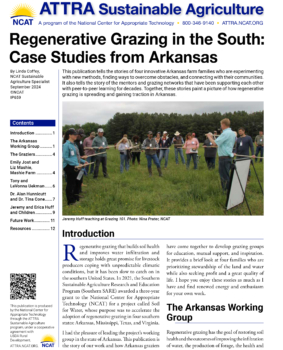Regenerative Grazing in the South: Case Studies from Arkansas
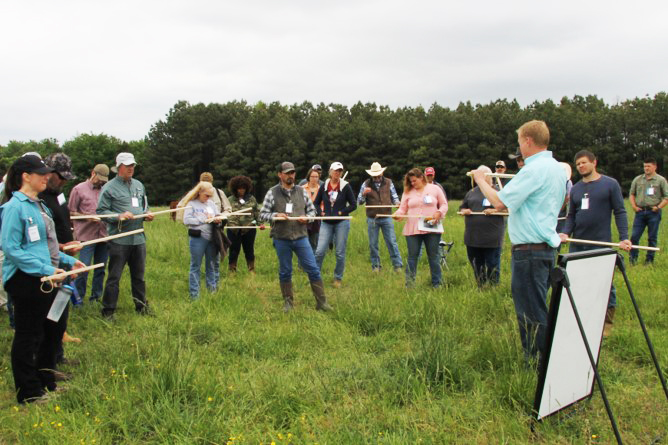
Jeremy Huff teaching at Grazing 101. Photo: Nina Prater, NCAT
By Linda Coffey, NCAT Sustainable Agriculture Specialist
Abstract
This publication tells the stories of four innovative Arkansas farm families who are experimenting with new methods, finding ways to overcome obstacles, and connecting with their communities. It also tells the story of the mentors and grazing networks that have been supporting each other with peer-to-peer learning for decades. Together, these stories paint a picture of how regenerative grazing is spreading and gaining traction in Arkansas.
Contents
Introduction
The Arkansas Working Group
The Graziers
Case Study: Emily Jost and Liz Mashie, Mashie Farm
Case Study: Tony and LeVonna Uekman
Case Study: Dr. Alan Hunnicutt and Dr. Tina Cone
Case Study: Jeremy and Erica Huff and Children
Future Work
Resources
Introduction
Regenerative grazing that builds soil health and improves water infiltration and storage holds great promise for livestock producers coping with unpredictable climatic conditions, but it has been slow to catch on in the southern United States. In 2021, the Southern Sustainable Agriculture Research and Education Program (Southern SARE) awarded a three-year grant to the National Center for Appropriate Technology (NCAT) for a project called Soil for Water, whose purpose was to accelerate the adoption of regenerative grazing in four southern states: Arkansas, Mississippi, Texas, and Virginia.
I had the pleasure of leading the project’s working group in the state of Arkansas. This publication is the story of our work and how Arkansas graziers have come together to develop grazing groups for education, mutual support, and inspiration. It provides a brief look at four families who are prioritizing stewardship of the land and water while also seeking profit and a great quality of life. I hope you enjoy these stories as much as I have and find renewed energy and enthusiasm for your own work.
The Arkansas Working Group
Regenerative grazing has the goal of restoring soil health and the outcomes of improving the infiltration of water, the production of forage, the health and productivity of livestock, and the abundance of life. In Arkansas, the Natural Resources Conservation Service (NRCS), Cooperative Extension Service, conservation districts, watershed organizations, and many other governmental and non-governmental organizations have been working for decades to provide farmers with education and inspiration on regenerative grazing. More than 25 years ago, the Grassroots Grazing Group began with a grant from the Environmental Protection Agency (EPA) and additional funding from Southern SARE. Since the group began, members have been mentoring each other, hosting pasture walks, and organizing conferences. In addition, the Arkansas Grazing Lands Coalition promotes and supports good grazing management, as does the Arkansas Forage and Grasslands Council (AFGC). NCAT has also been active, beginning with Dr. Ron Morrow and Dr. Ann Wells, DVM, inspiring many during the 1990s and 2000s, as they continue to do today.

Ron Morrow and Linda Pechin-Long, HMI trainer. Photo: Linda Coffey, NCAT
The Soil for Water project in Arkansas sought to bring together these entities with innovative producers, to achieve several goals:
-
- Communicate what is being done.
- Plan new activities that will increase adoption of better grazing management.
- Work together to collect resources and develop events.
- Encourage those who are working in areas of the state that have not been as active.
- Interact with people in the other states in the project (Mississippi, Texas, and Virginia) to get new ideas and inspiration.
In a survey near the beginning of the Soil for Water project, participants identified the two biggest barriers to regenerative grazing as “It goes against the status quo” and “Lack of evidence/information about the benefits of adoption (financial, environmental, etc.).” In Arkansas, we decided to address these barriers by holding more field days, pasture walks, and grazing schools, and by finding individuals to champion regenerative grazing in locations across the state.
Our working group (composed of many individuals and entities with years of experience) hosted field days, pasture walks, and two different two-day on-farm events at the Uekman farm in Quitman, Arkansas. One grazing school was taught by team members who brought their own experience to the training. Hands-on work allocating pasture, installing fence, and doing pasture and soil assessments sent students home equipped and excited to manage their grazing better. Additionally, Dr. Dirk Philipp from the University of Arkansas conducted research to assess the impacts of grazing intensity on moisture levels in soil. And Holistic Management International offered instruction that included a two-day class followed by a Regenerative Agriculture Mentoring Group (RAMP) that included webinars and on-farm visits with the support of a trainer. I was a member of that RAMP group, and we worked on holistic goals, testing decisions, and learning about ecological systems and monitoring.
A shout-out to our mentors, Dr. Ron Morrow and Dr. Ann Wells, DVM
I want to take this opportunity to publicly thank two mentors who have impacted me and many others in Arkansas, with ripples of influence expanding to other states.
Dr. Ron Morrow at a pasture walk. Photo: Linda Coffey, NCAT
Dr. Ron Morrow was my favorite professor at the University of Missouri in the fall of 1981, where he was teaching Intro to Animal Science and Beef Production and was the sponsor of the Block and Bridle Club. Later, he teamed up with Jim Gerrish to develop the Missouri Grazing School, with the aim of teaching producers how to do what they termed Management Intensive Grazing (MIG). Dr. Morrow was a lively, engaging instructor with memorable tricks to get his points across. Over the years, the Missouri Grazing School initially developed by Dr. Morrow and Jim Gerrish has taught and influenced many thousands of producers.
Dr. Ann Wells. Photo: Matthew Wells
Later, Dr. Morrow moved to Arkansas (where his family farm is) and joined the staff at NCAT, where he met Dr. Ann Wells, DVM. They partnered on projects to teach grazing management, understanding that practice as the key to a sustainable ruminant livestock business. One of their projects included starting the Grassroots Grazing Group, which still is active and continues to be a community of supportive and enthusiastic graziers, more than 25 years later.
Dr. Morrow and Dr. Wells taught grazing workshops all over the South and stressed holistic thinking, observation, and continual adjustment. After leaving NCAT, Dr. Morrow went to the NRCS and served as the Arkansas State Grazing Lands Specialist, where he implemented education to spread the message further and deeper. At the same time, he was managing cattle on his own farm and hosting many field days and pasture walks to show others how land could be managed with very few inputs. Meanwhile, Dr. Wells worked for Heifer International and the Kerr Center before retiring to serve as a private consultant, buy her own farm, and operate the business she and Dr. Morrow started more than 25 years ago, Ozark Pasture Beef. She continues to teach about holistic animal health, actively mentoring many young farmers and serving as science advisor for the Soil for Water project. Thank you, Dr. Ron Morrow and Dr. Ann Wells, for tirelessly and generously using your experience, knowledge, and energy to help so many do a better job with their land and animals.
The Grassroots Grazing Group (GGG)

GGG pasture walks let you see forages, livestock, infrastructure, and friends! Pictured are Claire Whiteside, Ann Wells, Emily Jost and daughter, and Tina Cone. Photo: NCAT
The Grassroots Grazing Group operates in the northwest corner of Arkansas and for more than 25 years has facilitated education and connection through pasture walks, a yearly conference, and peer networking. The group believes pasture walks are the best way to allow a farmer to see and feel the impacts of improved grazing management. Peer-to-peer learning happens when you gather a group and give them space and time together. These events help grow friendships and mentoring relationships, help farmers share what has been working (and what hasn’t) to solve real-world problems and give producers much-needed support, encouragement, and help with challenges.
The mid-day pasture walks include a potluck lunch. Often, a representative from the NRCS speaks about opportunities for cost-share funding or new programs. The Beaver Watershed Alliance and the Illinois River Watershed Partnership have sponsored pasture walks, and they help with outreach, as do the Cooperative Extension, NRCS, and conservation districts. Individual members volunteer to run the Facebook page, serve as treasurer, and serve on the planning committee to keep the calendar full. Membership dues are low, and benefits are high. Consider starting a group in your area! It’s a fun way to get to know like-minded producers, and you are guaranteed to learn something at every farm.
The Graziers
Case Study: Emily Jost and Liz Mashie, Mashie Farm
Goshen, Arkansas
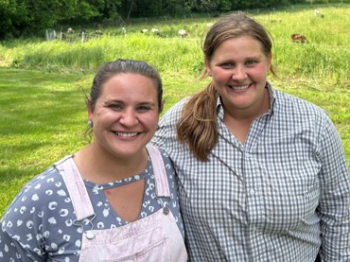
Liz Mashie (left) and Emily Jost, May 2024, at a farm tour. Photo: Linda Coffey, NCAT
Mashie Farm operates on a forage base of fescue and legumes and various other cool-season grasses and warm-season plants, including a lot of johnsongrass. Emily Jost and Liz Mashie are sisters who work together with the help of their mother, Mary, and their husbands to care for the family farm purchased by their parents in 1985. Their father David ran the farm as a conventional cow-calf/hay farm, splitting the farm in half and giving the cattle half and cutting hay on the other side. As girls, Emily and Liz felt that growing up on the farm was a “magical” upbringing that gave them a strong love for the land.
Learn More about Mashie Farm
Conservation Champions: Local Farmer Highlight, Emily Jost
Soil and Water Health Practices on the Mashie Farm, Beaver Watershed Alliance, April 2023.
As young adults now with families of their own, Emily and Liz strive to be good stewards of the family farm and livestock. Liz works full-time off the farm but maintains responsibility for the sheep flock, while Emily handles the cow-calf operation, grassfed steers, forested pigs, and honeybees. Mary helps with communication, childcare for Emily’s newborn and toddler daughters, and keeping home base (and the garden and yard).
Sadly, David Mashie passed away in 2022, but his legacy of love for the land and family lives on.
Emily was the catalyst for change in her family farm. She has been very proactive in seeking out education and mentors, and she attended workshops and a short course, read books, and did a lot of thinking about how to implement a system that would be good for the land and would cut costs on the farm. At a Southern Sustainable Agriculture Working Group (SSAWG) conference short course, she connected with mentors and peers James Maginot and Lauren Manning and Dr. Ann Wells. This has proved invaluable, and Emily credits her mentors with helping her keep learning and stay encouraged.
As part of a multi-generational farm, once Emily was convinced of the value of regenerative grazing, she needed to persuade her family members. The turning point was a grazing school event. Emily brought Liz and their dad, and all of them heard the
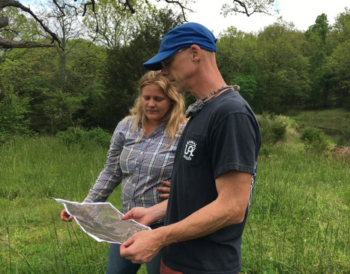
Emily Jost and Dr. Dirk Philipp look over the farm map. Photo: Linda Coffey, NCAT
compelling story of the host family’s adopting regenerative grazing for economic reasons, resulting in dramatically lower costs, higher profits, and improved health of cattle, forages, and soils. This convinced David to give Emily the green light to try it on the home farm.
Emily began dividing up pastures using polywire and training their cattle to rotate. The problem was water. She explains, “I had to make lanes, so many lanes to water, and it took me hours to set up a field for a week. And after the first year, we were like, this is not worth it if we can’t fix that water issue. So, I applied for funding through the NRCS EQIP program, and the first thing we did was install five tire tanks. We also installed some electric fence. Now we can work through our fields much easier off the center water points.”
Emily, her husband Luke, and both her parents attended a Holistic Management International class through the Soil for Water project and worked on their family holistic goal. This improved inter-generational communication.
Benefits and Challenges
Since converting to regenerative grazing, Emily and Liz report improved forage production, animal health, diversity, water infiltration, and manure distribution. They appreciate the frequent contact with the land and the animals and report feeling more connected. Quality of life has improved with much less hay feeding, and Emily’s daily management takes just 15 to 20 minutes a day. Liz’s management is more difficult because sheep are much more challenging to fence. While electric netting makes it possible to graze more areas, it’s time-consuming to place. In summer, electric netting doesn’t hold enough charge, and Liz finds that three strands of polywire keep hot better.
For Emily and Liz, the biggest challenge is still water. They’re getting more tanks and thinking about how to freeze-proof them, but tire tanks are too tall for the sheep, which can mean hauling water. Another challenge is minimizing fescue toxicity issues for both cattle and sheep.
For two busy young mothers, making time is also a challenge, but as Liz explains, “This is part of my identity: raising livestock is part of who I am, and I enjoy my time on the farm.”
Emily notes that funding from the NRCS EQIP program and private foundations has accelerated the pace of change on their farm. Meanwhile, Liz identifies communication as a critical part of the family farm team’s success. “We’re all trying to do the right thing; we need each other, and working together, it’s been fun.”
In terms of providing advice for beginners, Emily says that mentors have been key for her in answering questions and providing guidance. Liz stresses the need to be resilient. “There’s no year or season of farming that’s NOT hard. Even if it’s really great, you’re going to work hard, do hard things, see hard things, make hard decisions…Accepting that as part of it is critical.”
Liz sums up the family farming legacy, “I give credit to the way we grew up, to our parents and what they instilled in us. It feels like a connection to the core of who you really are and what your family has stood for – the land and the life and the life force.”
It’s inspiring to me to visit the Mashie Farm and see what the family has accomplished and how they work together to keep improving the land. Education, funding, resilience, mentors, passion, and the family legacy are all keys to their continued success.
Case Study: Tony and LeVonna Uekman
Quitman, Arkansas
Tony and LeVonna Uekman, who both recently retired from the NRCS, are long-time graziers and mentors, and their farm serves as a great model. LeVonna first attended the Missouri Grazing School years ago, and Tony quickly saw the benefits of subdividing and rotating and resting. They began by grazing stocker cattle on contract. Currently, they have a cow-calf operation and finish steers on grass.

Tony and LeVonna Uekman discuss the afternoon agenda at Grazing 101. Photo: Linda Coffey, NCAT
The Uekmans hosted three events for the Soil for Water project and several other events for the NRCS, working closely with State Grazinglands Specialist Jeremy Huff in providing hands-on opportunities for NRCS agents and for producers.
Learn More about Tony and LeVonna Uekman
Managed Intensive Grazing of Beef Cattle Preview, Southern SAWG, 2012
Farm Family of the Year, Faulkner County, 2012

LeVonna and Tony Uekman discuss the next move at Grazing 101. Photo: Linda Coffey, NCAT
Tony specializes in water systems. He understands the engineering, NRCS specifications and programs, the materials, and the needs of cattle. LeVonna and Tony both bring depth of knowledge and experience to managing the forages and cattle.
The Uekmans encourage others to, “Just start! Don’t wait for NRCS funding to begin managing your land better!” Tony points out that you will save money by doing better management. If an NRCS contract is accepted, great, but if not, you should do it anyway.
Tony and LeVonna have generously given their time, knowledge, and skills to helping others and have been an instrumental part of the Soil for Water team. It’s inspiring to see what they have achieved and how they educate and encourage others.
Case Study: Dr. Alan Hunnicutt, DVM, and Dr. Tina Cone, DVM
Berryville, Arkansas
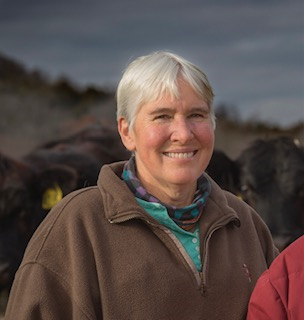
Tina Cone. Photo: Cary Pollock
Dr. Tina Cone, DVM, and Dr. Alan Hunnicutt, DVM, in Berryville, Arkansas, are retired veterinarians who are currently managing about 2,000 contiguous acres using cattle to graze regeneratively. They operate on a forage base of fescue, annual ryegrass, orchardgrass, hop clover, white clover, vetch, Kentucky bluegrass, and annual brome in the cool season; and bermudagrass, crabgrass, johnsongrass, eastern gamagrass, switchgrass, bluestem, various forbs, sweetclover, dallisgrass, barnyardgrass, panicum, purpletop, and indiangrass in the summer. They move cattle daily and keep them in uniform groups with a spring-calving herd in one location and a fall-calving herd in another. Their son Matt works with them, and each person has responsibility for specific herds.
Learn More about Dr. Cone
ATTRA Podcast #268: Managing Land, Cattle, and Quality of Life
They began in 1982 with Holstein bottle calves. Later, Alan would buy third-period cows from the sale barn that were the start of their beef herd. Over time, they added parcels that joined their land, so they could run more cattle. Rented land is important in their endeavors, too.
Alan said a subscription to the Stockman Grass Farmer and a grazing school taught by Dr. Ron Morrow and Jim Gerrish started him on rotational grazing. Tina said that going to a grazing school helped her overcome her initial resistance. “Right at the start, I thought it was the ugliest fencing and I was just so traditional and sort of horrified, actually, and then he was smart enough to get me to go to the grazing school. Then I got the science of it and also the economics of it because that fence is so cheap and easy because if you don’t like it, you can change it. It’s easy to repair, and the cattle actually respect it more than other fences. It works well for us.”
Alan reflected that in the early days of the Grassroots Grazing Group, going to other farms and learning from each other was so important because no one had much experience building fence, and the equipment wasn’t as good as it is today. He notes, “One good thing about GGG, you at least have a few people around that may have had a similar problem. But you know then, nobody had built enough fence to really know what they were doing. We just learned by experience, trial and error. We made a lot of errors! But the errors you make are easily corrected. If you build a fence somewhere and it’s not in the right place, you can move it.”
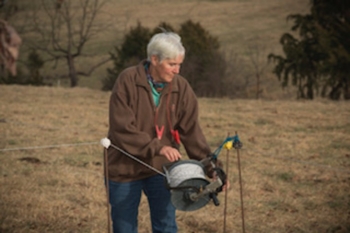
Tina Cone. Photo: Cary Pollock
Tina says that when they started out, the challenge was finding time to work on the farm amid careers and family responsibilities. “We put in really long hours at our practice. We had two little boys, aging parents, three clinics, a lot of employees, a lot of stuff to take care of. Now we have quite a bit more time, but I don’t think either one of us has as much energy or drive!” Alan adds that, with experience, they can take care of more cattle with less hours of labor. He once figured out that moving fence was equivalent to making $100 an hour because it meant they didn’t feed any hay, due to grazing management.
Alan and Tina identify land costs and urban encroachment as significant challenges. They explain that development on agricultural land has particularly affected Matt with the loss of leased land and is a problem across the country. They say that now it’s harder to find farms sizable enough to lease because they’re too small to be viable. At the same time, they see opportunities for young farmers, as older farmers age out of the business.
Tina says the key to success is that “You just have to start doing it and be consistent and patient.” Alan adds that not running out of grass and not being overstocked are important. “If it looks like we might be short, we start selling cattle. Weaned steers first, then heifers, then cull cows.”
Tina and Alan agree on advice to beginners: “Find a mentor and choose your enterprise to fit your acreage. Unless you have at least 80 acres, cow-calf is not feasible. Keep debt small and manageable and pay it off quickly. And make your money work for you; don’t put all your eggs in one basket. Don’t get overloaded with equipment, and always live beneath your means.”
Tina and Alan say the most important equipment for a beginning grazer is reels, some posts, a charger, clipper leads, and a fence tester. To save time, they recommend geared reels with guards to keep the wire from getting backlashed.
Alan and Tina also offer advice on renting land for grazing. “First, choose well. It needs to be large enough and close enough to be worthwhile. And you have to be able to figure out water. Then, do an excellent job stewarding the land. Landowners appreciate that. Build relationships. Maybe you gift the landowner some beef, or bring over leftovers to share, or just call or stop by to check in. Sometimes a little “cosmetic brush-hogging” is in order. Be sure the view from the landowner’s window is a good one.”
They sum up the benefits of their grazing practices as follows:
-
- Improved organic matter provides spongy soil that holds water, reducing runoff and growing more forage while protecting the watershed.
- Long rest periods (60 to 90 days) have resulted in great forage diversity and plenty of forage when the cattle get there.
- Animals are calm and healthy.
- Cost of production is low. They don’t use hay or feed or even minerals, and rarely do any weed control because, with the grazing pressure, the cattle handle it.
- An intimate knowledge of the land helps them tell when forage is running out so they can adjust by selling cattle.
- This enjoyable work takes only a couple of hours a day. They can handle a lot of cattle in a short time.
Alan and Tina are wonderful examples of what can be accomplished with hard work, timing, good luck, and consistent and intelligent effort. The satisfaction they experience as stewards of the land and cattle keeps them doing this work past retirement age and mentoring and inspiring new producers.
Case Study: Jeremy and Erica Huff and Children
Mena, Arkansas
Jeremy and Erica Huff came from conventional cow-calf backgrounds and, with their two children, raise cattle, hogs, and pastured turkeys on their farm that adjoins Jeremy’s family farm. He is the Arkansas NRCS State Grazing Lands Specialist and has continued some of the initiatives begun by his predecessor, Ron Morrow, notably teaching Pasture Ecology classes. Jeremy has put a lot of work, thought, energy, and time into strengthening the NRCS team that works with producers. He’s had a huge influence in encouraging regenerative grazing, both through his own educational efforts and those of the field staff. He also works to develop new practice standards that support farmers in their efforts, including liming pastures and unrolling bales.
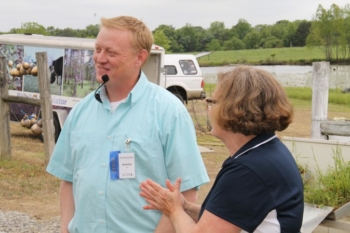
Jeremy Huff and Claire Whiteside, NRCS, at Grazing 101. Photo: Nina Prater, NCAT
The Huffs’ journey to regenerative grazing began when they moved back to Mena, bought and cleared their land, and began using rotational grazing on a ryegrass and crabgrass forage base. Jeremy was interested in good rotational grazing practices, personally and professionally. “I knew that I need to do it at home. I can’t go out and do talks and teach and promote it to others if I’m not doing it myself,” he says.
In his role with NRCS, Jeremy has championed the model of hands-on learning. He encourages training and teaches Pasture Ecology I and Pasture Ecology II courses as professional development for NRCS agents. These multi-day courses blend classroom and on-farm work and give NRCS staff a chance to practice and reinforce the learning. He’s an excellent teacher who puts a lot of effort and thought into his trainings. For producers, he’s been active in doing field days and webinars. As an integral part of the Soil for Water team, Jeremy helped plan and did a great part of the teaching for the Arkansas Grazing 101 school.

Jaylie Huff finds the work easy! Photo: Jeremy Huff
On their own farm, it’s Erica who handles the day-to-day grazing management. Jeremy and Erica give each other a lot of credit for their success. For example, Erica finds the day-to-day work very easy and a welcome relief from her stressful job, due to planning that helps them provide water efficiently. “Because he masterminded this when we bought the place, and we put our water line in so quick connects are spaced out down the driveway. So, we just set a water tank within water-hose reach of that and we’re good to go.” Erica or their 13-year-old daughter can move water and cattle and fence in just 20 to 30 minutes per day.
Jeremy identified shade as a challenging issue in their operation. However, both mentioned that the animals are calm and healthy with good forage, and that calving time is the only time they have to observe the cattle a lot.
Erica identifies consistency as a key to success in rotational grazing. “Getting out there every day, and even if it’s just walking through it and checking on it and you know what, they have another day of grazing, they can stay right here—it’s every day getting out there and doing something.”
Jeremy agrees, and adds, “It’s all about leaf content. When in doubt, move. And if you think you are grazing too short, you are. We graze for regrowth and that’s what we do 90% of the time. The other 10% is like what we’re doing now, applying more grazing pressure to get the cool-season grass down to allow the crabgrass to come in.”
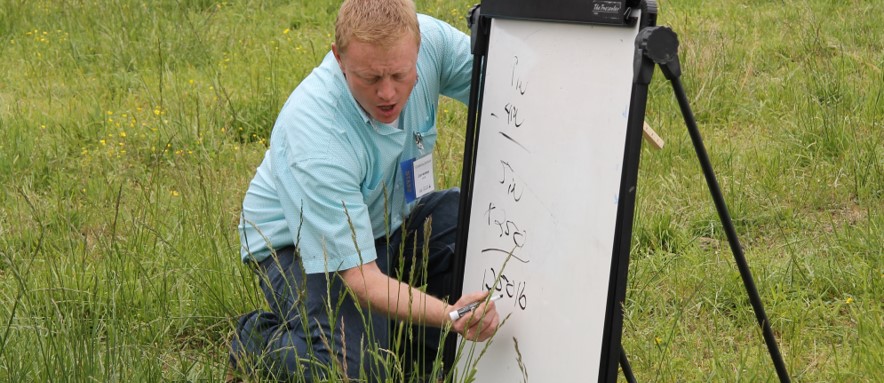
Jeremy Huff demonstrates grazier’s math. Photo: Nina Prater, NCAT
Erica advises beginners: “Keep going. I’m going to be honest. When he told me about rotational grazing, with the way I was raised, I was like, ‘You’ve got to be kidding me! This is not going to work!’ But it works beautifully, and I’m a lifelong fan now because it works that well.” Jeremy adds, “How your system is set up either makes life easier or harder. So, if it’s set up to be difficult, then beginners will get discouraged. Or you can set a system where it provides a lot of convenience. It’s not that difficult to understand what we’re trying to achieve. So, keep it simple and have a plan in place for your grazing system.”
Advice for Beginners
- Keep going. It’s a complex biological system you are working with. Positive change will happen if you see it through.
- Set up your system for success. The way your grazing system is laid out and operated will either make your life easier or harder.
- Keep it simple. Start slow, observe how animals behave in the system, and let them have time to get used to their new routine. Once you have become comfortable with your new system, add more paddocks or increase your stock density and see what happens. Learn as you go.
Jeremy and Erica make a great team: she insists she learns something from him all the time, while he maintains that she sees things that he doesn’t, and that she is the specialist on their farm. Both take a lot of satisfaction from the benefits they have seen:
-
- Better forage production than expected from the thin, low-fertility soils.
- Stocking rate that matches neighboring farms that have much better soils.
- Calm cattle.
- No pest problems (just an observation, not a claim of cause and effect, Jeremy said).
- Easy management.
- Enjoyable routine, stress-relieving for Erica.
- The farm works to help Jeremy give a real-world test of recommendations.
With two active teenagers, two demanding jobs, and extensive community involvement, this couple has their plate very full. It’s inspiring that they continue to steward the land and livestock and identify the cattle operation as stress-relief. It’s clear why the system needs to be well-planned and simple to execute.
Future Work
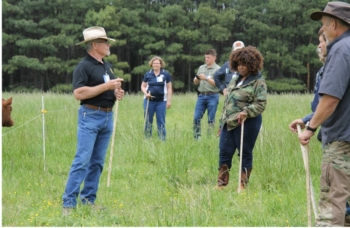
Dr. David Fernandez, UAPB, teaching at Grazing 101. Photo: Photo: Nina Prater, NCAT
Moving forward, the Soil for Water working group in Arkansas hopes to continue to promote better grazing practices through our collaborative work. The Arkansas Grazing Lands Coalition website could house case studies and helpful resources, including video clips that demonstrate key technologies, such as electric fencing and watering systems. Resources used by the grazing school could be made widely available, and we want to publish articles in the press to reach beyond the choir. There is much work to be done in other parts of the state, and we plan to keep trying to promote pasture walks and other peer-to-peer learning.
The benefits of mentoring and of producer groups are evident through the longevity of many in the GGG. One idea is that we assemble small groups of experienced producers to mentor a newer one, visit the farm, and assist in setting up a plan. As Jeremy Huff stated, that can make all the difference in feasibility of management.
We hope the case studies here serve as encouragement as you work to promote and practice excellent land stewardship, wherever you are.
Take-home Messages from the Arkansas Working Group
- Land-use planning is a critical need in Arkansas, particularly in the northwest and central areas. Preserving land for agricultural uses and linking new farmers with retiring ones are two important tasks.
- Expect initial resistance. Each of our profiled families had someone with a strong negative reaction at first, or skepticism at the very least. After trying it, they are now enthusiastic practitioners.
- Having a grazing setup that’s easy to use will help busy families maintain consistency and see results.
- Support from others helps with motivation and key skills. Building community is important for longevity. Mentors make a difference!
- Extra funding is helpful in setting up good infrastructure. But it will pay off even without extra funding; “Just start!” says Tony Uekman.
- Once good infrastructure is in place, time commitment is low and the payoff in improved health for soil, forages, livestock, and finances is high. Satisfaction and enjoyment of the work are other important benefits.
- Succession planning can help keep lands in production and set up the next generation for success.
- The work that is being done now has consequences for the future. What Dr. Ron Morrow began in Missouri in the 1980s is still bearing fruit today. Forty years from now, the choices we make today will still matter.
Resources
Soil for Water
NCAT’s Soil for Water project website celebrates the amazing water-holding ability of healthy soil and encourages on-farm research and discovery. It includes a story collection, peer-to-peer learning opportunities, and resources for farms and ranches interested in catching and holding more water in their soils.
Managing Soils for Water: How Five Principles of Soil Health Support Water Infiltration and Storage
Too often, the approach to dealing with water deficits has focused exclusively on better technology: deeper wells, better drip emitters, more efficient micro-sprinklers, and variable-speed drives on pumps. While all of these are important, this ATTRA publication discusses a different approach that focuses on maintaining healthy soils by following five basic principles.
Grazing Networks for Livestock Producers
Grazing networks promote a mutual self-help approach to learning that is based on shared local experience and provides several benefits to participants. This publication offers suggestions for finding or starting a grazing network and provides examples of the kinds of activities grazing networks might conduct. It also contains recommendations for sustaining a grazing network over time.
Key Organizations Supporting Regenerative Grazing in Arkansas
Arkansas Forage and Grasslands Council
Arkansas Grazing Lands Coalition
Illinois River Watershed Partnership
Acknowledgment
This publication is based upon work that is supported by the National Institute of Food and Agriculture, U.S. Department of Agriculture, under award number 2020-38640-31521 through the Southern Sustainable Agriculture Research and Education program under subaward number LS21-345. USDA is an equal opportunity employer and service provider. Any opinions, findings, conclusions, or recommendations expressed in this publication are those of the author(s) and do not necessarily reflect the view of the U.S. Department of Agriculture.
![]()

